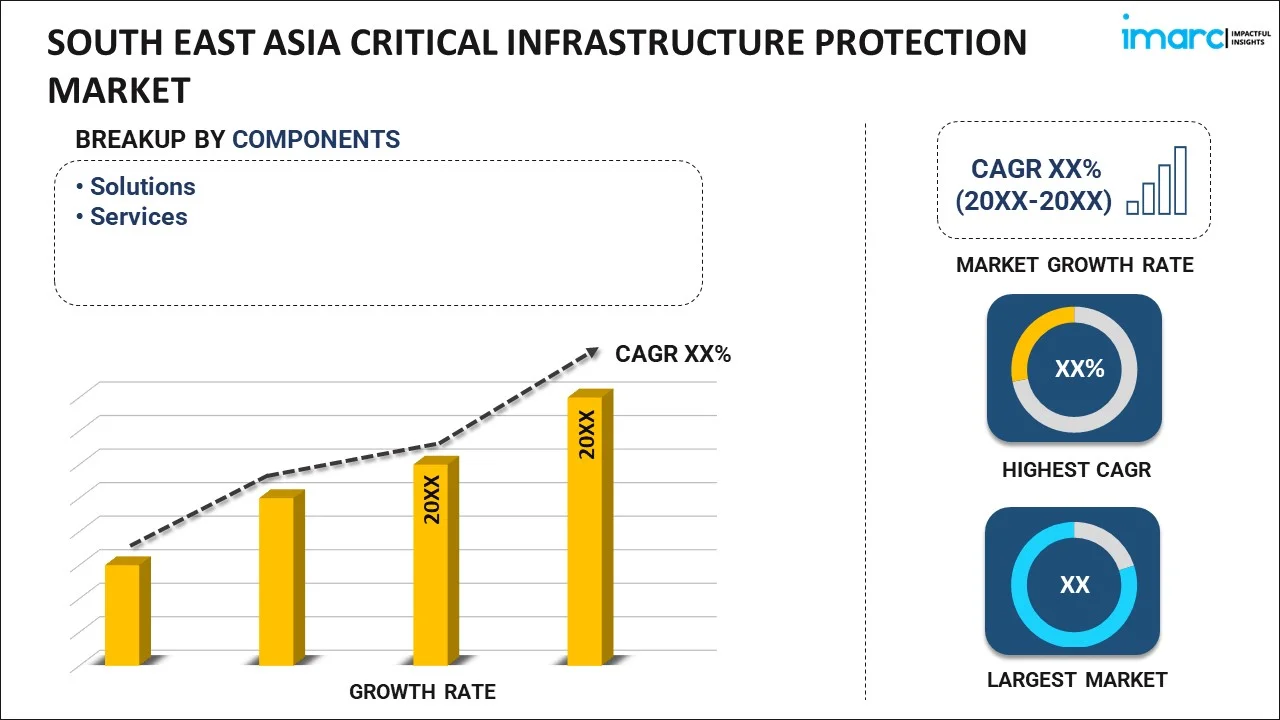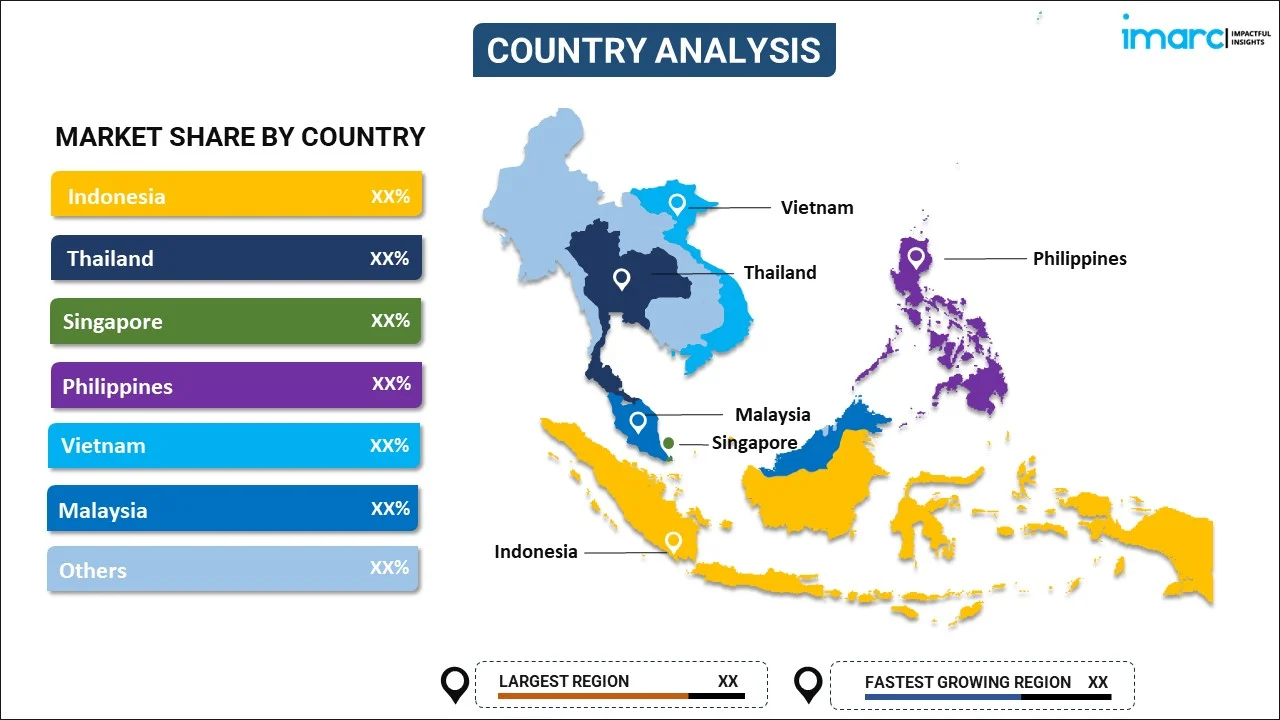
South East Asia Critical Infrastructure Protection Market Report by Component (Solutions, Services), End User (Financial Institutions, Government, Defense, Transport and Logistics, Energy and Power, Commercial Sector, and Others), and Country 2024-2032
Market Overview:
South East Asia critical infrastructure protection market size is projected to exhibit a growth rate (CAGR) of 4.70% during 2024-2032. The rising focus of government bodies on ensuring public safety and also preventing potential environmental disasters is primarily driving the regional market.
|
Report Attribute
|
Key Statistics
|
|---|---|
|
Base Year
|
2023 |
|
Forecast Years
|
2024-2032
|
|
Historical Years
|
2018-2023
|
| Market Growth Rate (2024-2032) | 4.70% |
Critical infrastructure protection (CIP) is a security measure implemented to defend systems, assets, and networks against potential threats. It encompasses a range of solutions, including firewalls, identity and access management, risk and compliance management, antivirus programs, intrusion detection systems, and encryption systems. These security measures are in place to safeguard information related to critical infrastructure such as power grids, railways, nuclear plants, and hydro plants from cyber threats that could jeopardize public safety, pose risks to national security, or result in environmental disasters. Critical infrastructure protection solutions utilize wireless technology, industrial control systems (ICS), operational technology (OT), and supervisory control and data acquisition (SCADA) systems, revealing additional vulnerabilities that may need to be addressed for comprehensive protection.
South East Asia Critical Infrastructure Protection Market Trends:
The critical infrastructure protection market in South East Asia is witnessing substantial growth and strategic importance, driven by the region's increasing reliance on interconnected and technology-dependent critical infrastructure. One of the key factors contributing to the growth of the market is the region's heightened awareness of cybersecurity risks and the potential impact on public safety and national security. Moreover, the South East Asia critical infrastructure protection market encompasses a range of security solutions, including firewalls, identity and access management, risk and compliance management, antivirus programs, intrusion detection systems, and encryption systems. Besides this, as the region experiences rapid urbanization and technological advancement, critical infrastructure becomes more interconnected, making it susceptible to cyberattacks. Furthermore, government bodies and organizations in South East Asia are investing significantly in CIP solutions to mitigate risks and enhance the resilience of their critical infrastructure. Apart from this, the market presents opportunities for innovation, collaboration, and the development of tailored solutions to fortify the region's critical infrastructure against emerging cybersecurity challenges. As South East Asia continues its digital transformation, the critical infrastructure protection market is poised to play a pivotal role in safeguarding the foundation of the region's economic and societal well-being in the coming years.
South East Asia Critical Infrastructure Protection Market Segmentation:
IMARC Group provides an analysis of the key trends in each segment of the market, along with forecasts at the regional and country levels for 2024-2032. Our report has categorized the market based on component and end user.
Component Insights:

- Solutions
- Physical Security Solutions
- Physical Identity and Access Control Systems
- Perimeter Intrusion Detection Systems
- Video Surveillance Systems
- Screening and Scanning
- Others
- Cyber Security Solutions
- Encryption
- Network Access Control and Firewall
- Threat Intelligence
- Others
- Physical Security Solutions
- Services
- Designing and Integration Services
- Consultation Services
- Risk Management Services
- Maintenance and Support Services
The report has provided a detailed breakup and analysis of the market based on the component. This includes solutions [physical security solutions (physical identity and access control systems, perimeter intrusion detection systems, video surveillance systems, screening and scanning, and others) and cyber security solutions (encryption, network access control and firewall, threat intelligence, and others)] and services (designing and integration services, consultation services, risk management services, and maintenance and support services).
End User Insights:
- Financial Institutions
- Government
- Defense
- Transport and Logistics
- Energy and Power
- Commercial Sector
- Others
A detailed breakup and analysis of the market based on the end user have also been provided in the report. This includes financial institutions, government, defense, transport and logistics, energy and power, commercial sector, and others.
Country Insights:

- Indonesia
- Thailand
- Singapore
- Philippines
- Vietnam
- Malaysia
- Others
The report has also provided a comprehensive analysis of all the major regional markets, which include Indonesia, Thailand, Singapore, Philippines, Vietnam, Malaysia, and Others.
Competitive Landscape:
The market research report has also provided a comprehensive analysis of the competitive landscape in the market. Competitive analysis such as market structure, key player positioning, top winning strategies, competitive dashboard, and company evaluation quadrant has been covered in the report. Also, detailed profiles of all major companies have been provided.
South East Asia Critical Infrastructure Protection Market Report Coverage:
| Report Features | Details |
|---|---|
| Base Year of the Analysis | 2023 |
| Historical Period | 2018-2023 |
| Forecast Period | 2024-2032 |
| Units | US$ Million |
| Scope of the Report | Exploration of Historical and Forecast Trends, Industry Catalysts and Challenges, Segment-Wise Historical and Predictive Market Assessment:
|
| Components Covered |
|
| End Users Covered | Financial Institutions, Government, Defense, Transport and Logistics, Energy and Power, Commercial Sector, Others |
| Countries Covered | Indonesia, Thailand, Singapore, Philippines, Vietnam, Malaysia, Others |
| Customization Scope | 10% Free Customization |
| Report Price and Purchase Option | Single User License: US$ 3699 Five User License: US$ 4699 Corporate License: US$ 5699 |
| Post-Sale Analyst Support | 10-12 Weeks |
| Delivery Format | PDF and Excel through Email (We can also provide the editable version of the report in PPT/Word format on special request) |
Key Questions Answered in This Report:
- How has the South East Asia critical infrastructure protection market performed so far and how will it perform in the coming years?
- What has been the impact of COVID-19 on the South East Asia critical infrastructure protection market?
- What is the breakup of the South East Asia critical infrastructure protection market on the basis of component?
- What is the breakup of the South East Asia critical infrastructure protection market on the basis of end user?
- What are the various stages in the value chain of the South East Asia critical infrastructure protection market?
- What are the key driving factors and challenges in the South East Asia critical infrastructure protection?
- What is the structure of the South East Asia critical infrastructure protection market and who are the key players?
- What is the degree of competition in the South East Asia critical infrastructure protection market?
Key Benefits for Stakeholders:
- IMARC’s industry report offers a comprehensive quantitative analysis of various market segments, historical and current market trends, market forecasts, and dynamics of the South East Asia critical infrastructure protection market from 2018-2032.
- The research report provides the latest information on the market drivers, challenges, and opportunities in the South East Asia critical infrastructure protection market.
- Porter's five forces analysis assist stakeholders in assessing the impact of new entrants, competitive rivalry, supplier power, buyer power, and the threat of substitution. It helps stakeholders to analyze the level of competition within the South East Asia critical infrastructure protection industry and its attractiveness.
- Competitive landscape allows stakeholders to understand their competitive environment and provides an insight into the current positions of key players in the market.
Need more help?
- Speak to our experienced analysts for insights on the current market scenarios.
- Include additional segments and countries to customize the report as per your requirement.
- Gain an unparalleled competitive advantage in your domain by understanding how to utilize the report and positively impacting your operations and revenue.
- For further assistance, please connect with our analysts.
 Inquire Before Buying
Inquire Before Buying
 Speak to an Analyst
Speak to an Analyst
 Request Brochure
Request Brochure
 Request Customization
Request Customization




.webp)




.webp)












